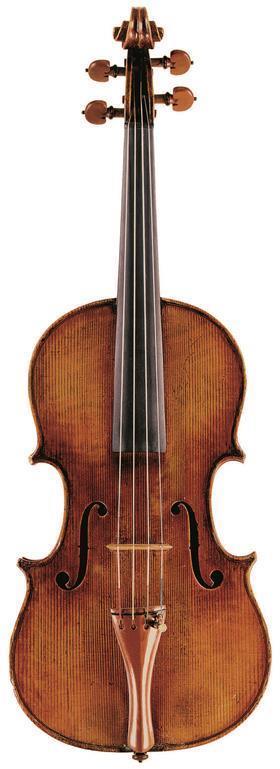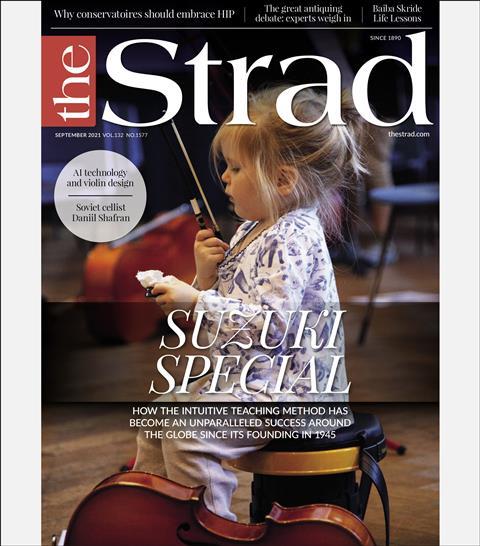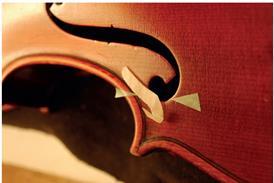In the September 2021 issue, William Castle examines how weight, shape and sound is affected in violas of various sizes

Photo: Paul Brickell/Sotheby’s
The back length of this Anselmo Bellosio viola is only 384mm
The following extract is from The Strad’s September 2021 issue feature on viola sizes ‘Size does matter’. To read it in full, click here to subscribe and login. The September 2021 digital magazine and print edition are on sale now
WEIGHT
The weight of an instrument is immediately apparent when you pick it up. The greatest part of the weight is the back, because this is the thickest part of the instrument’s body, and compared with the belly, the wood of the back is more dense. Its weight depends on its size, the density of the wood and its thickness, which in turn is determined by the qualities of the wood and the shape of the archings. So it is quite possible to have good instruments of the same model which are quite different in weight, so unfortunately you can’t decide on a viola by putting it on a set of scales! However, the musician has a better test readily available: the ears, because everything else being equal, an instrument that is too heavy in the body is likely to be restricted in its sound.
The second aspect of weight that affects the comfort of an instrument is its balance. If we allow that the body is well constructed for sound, with whatever weight that entails, there is still the neck and scroll, which, because they are a long way from the body, have a disproportionate effect on how easy it is to hold up the instrument. Many historical violas have quite large scrolls, some with shoulders to the pegbox like a cello scroll, but any extra size is all extra weight. Practically speaking, a viola pegbox needs to be no bigger than one for a violin, because it only needs to be large enough to hold four pegs and the ends of the strings, and although a big scroll may have some chunky aesthetic appeal, a scroll only 10 or 15 per cent bigger than a violin does not look out of place and keeps the weight to the minimum.
SHAPE
Besides varying in length, violas also differ in shape. The aspects that particularly affect player comfort are the shape of the neck, where only a small amount of extra thickness can make an awful lot of difference to how it feels, and the shape of the upper bouts. This is the part of the body around which your hand and arm need to move to reach higher positions. Not too much attention needs to be paid to the absolute width; more noticeable is how quickly the ribs drop away from the neck, but this must also be considered in relation to the fingerboard. Especially on old instruments where the fingerboard has been reworked many times, or where the neck has been planed down when fitting a new fingerboard, the surface of the fingerboard may be much nearer to the belly than is ideal, so the left hand not only has to reach around the top bout, but must also curl down more for the fingers to push the strings against the fingerboard. A long body length is also an important factor when playing in high positions, because on a larger instrument, not only must the arm reach further to get round the upper bout, but the wrist and hand must also reach further back again, creating more tension as you go for the top notes.
SOUND
Unfortunately, there is still a perception among some violists that you should play the biggest viola you can, never mind how long it takes you to become injured by doing so! This is based on the presumption that a bigger instrument must sound better, but this is not necessarily the case. However, it is easier to make a good-sounding instrument if it is over 406mm, which is one reason why there are so few good old violas under this size, and not many new ones either. Another important factor is the choice of strings, the ones used in the past not working nearly as well for short string lengths as modern strings, so many older violas now sound better than they once did. In terms of the sound produced, it would be a mistake to get stuck on the issue of size, because there is as much variation between instruments of the same size as there is between instruments of different sizes. Each instrument should therefore be treated as an individual, and depending on your own peculiarities of size and proportion, as well as your tonal preferences, there is probably a viola out there to suit everyone.
Read: Viola sizes: Size does matter
Read: In Focus: An 1875 viola by Domenico Degani
Read: Sentimental work: Jennifer Stumm on Rebecca Clarke’s Viola Sonata
-
This article was published in the September 2021 Suzuki issue
How the intuitive teaching method has become an unparalleled success around the globe since its founding in 1945. Explore all the articles in this issue
More from this issue…
- The Suzuki teaching method
- Why conservatoires should embrace HIP
- The great antiquing debate: experts weigh in
- Violin making and AI
- Soviet cellist Daniil Shafran
- Choosing the right sized viola
Read more playing content here
-




































No comments yet